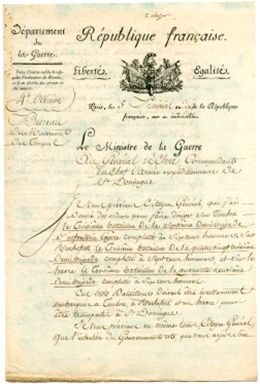 "The Leclerc Expedition" by Charles Forsdick, Ph.D.
"The Leclerc Expedition" by Charles Forsdick, Ph.D.
Forsdick is James Barrow Professor of French at the University of Liverpool. He has written and edited many books, such Victor Segalen and the Aesthetics of Diversity: Journeys between Cultures (2011) and Postcolonial Thought in the French-Speaking World (2009).
 By the late 1790s, the return of Saint-Domingue to relative stability allowed Toussaint Louverture to implement a series of policies that permitted reconstruction of the plantation economy, with the formerly enslaved transformed into cultivateurs whose freedom nevertheless remained heavily restricted. Although unpopular and challenged in a series of revolts, the re-established plantation system was further consolidated by Toussaint’s 1801 constitution, in which his powers were enhanced as he was made governor-for-life. In the coup of 18 Brumaire (in 1799), Napoleon Bonaparte had overthrown opposition and named himself First Consul, and in the context of these shifts he interpreted Louverture’s increase in his own political authority as a direct personal attack.
By the late 1790s, the return of Saint-Domingue to relative stability allowed Toussaint Louverture to implement a series of policies that permitted reconstruction of the plantation economy, with the formerly enslaved transformed into cultivateurs whose freedom nevertheless remained heavily restricted. Although unpopular and challenged in a series of revolts, the re-established plantation system was further consolidated by Toussaint’s 1801 constitution, in which his powers were enhanced as he was made governor-for-life. In the coup of 18 Brumaire (in 1799), Napoleon Bonaparte had overthrown opposition and named himself First Consul, and in the context of these shifts he interpreted Louverture’s increase in his own political authority as a direct personal attack.
 As Europe returned temporarily to peace (the Treaty of Amiens would be signed in March 1802), a portion of the French army was available for a transatlantic mission to defeat Toussaint and re-establish the former colonial order in Saint-Domingue. Under the command of General Charles Victor-Emmanuel Leclerc (Napoleon’s political ally, as well as his brother-in-law), a military expedition comprising of an initial 20,000 troops (and also including several of Toussaint’s political opponents, as well as his sons who had been at school in France) left the French Atlantic ports in December 1801; it arrived off Cap-Haïtien – then Cap Français – in February the following year. Pamphile de la Croix records Toussaint’s supposed reaction on observing this armada: ‘The whole of France has come to Saint-Domingue. [...] She comes to avenge herself and force the blacks back into slavery.’
As Europe returned temporarily to peace (the Treaty of Amiens would be signed in March 1802), a portion of the French army was available for a transatlantic mission to defeat Toussaint and re-establish the former colonial order in Saint-Domingue. Under the command of General Charles Victor-Emmanuel Leclerc (Napoleon’s political ally, as well as his brother-in-law), a military expedition comprising of an initial 20,000 troops (and also including several of Toussaint’s political opponents, as well as his sons who had been at school in France) left the French Atlantic ports in December 1801; it arrived off Cap-Haïtien – then Cap Français – in February the following year. Pamphile de la Croix records Toussaint’s supposed reaction on observing this armada: ‘The whole of France has come to Saint-Domingue. [...] She comes to avenge herself and force the blacks back into slavery.’
Although Toussaint’s army was not unified, and several generals rallied immediately to Leclerc, resistance remained fierce: Cap-Haïtien itself was raised to the ground, and Louverture drew the French into the interior of Saint-Domingue where his troops fought several major engagements, including the major defence of Crête-à-Pierrot, before finally surrendering in April 1802. Dessalines and Henry Christophe transferred their allegiance to the French, and Toussaint—a threat as long as he remained in the colony—was lured into a trap, arrested and imprisoned in France, where he would die at the Château de Joux in April 1803.
Meanwhile, news of the re-imposition of slavery in Guadeloupe by the Richepanse expedition in May 1802 made Bonaparte’s ultimate intentions for Saint-Domingue clear, and when Leclerc died of yellow fever in November 1802, the brutal tactics of his successor Rochambeau further succeeded in unifying the black and coloured armies in renewed resistance to the French.
As Europe returned temporarily to peace (the Treaty of Amiens would be Rochambeau was eventually defeated by Dessalines’ army—under the command of François Capois—at the Battle of Vertières on 18 November 1803, after which the remaining French, weakened additionally by the ravages of yellow fever among their ranks, capitulated and agreed to withdraw from the colony.
In this ill-fated effort to re-impose French authority in Saint-Domingue, Napoleon had lost many valued troops and sailors, and he subsequently recorded profound regret decades later in his memoirs for his decision to launch the expedition. On 1 January 1804, Dessalines formally declared the independence of Haiti, effectively ending Napoleon’s ambitions of re-establishing a major French colonial presence in the Americas.